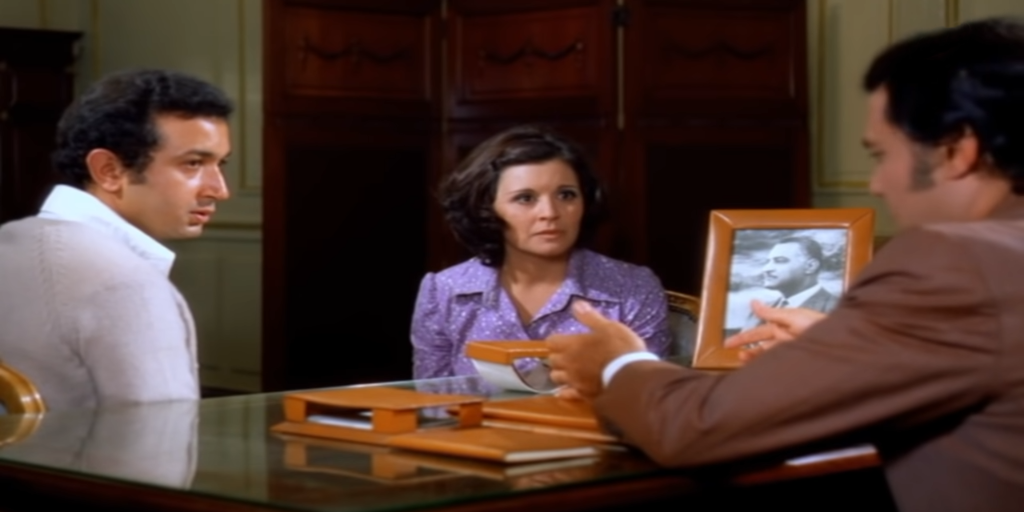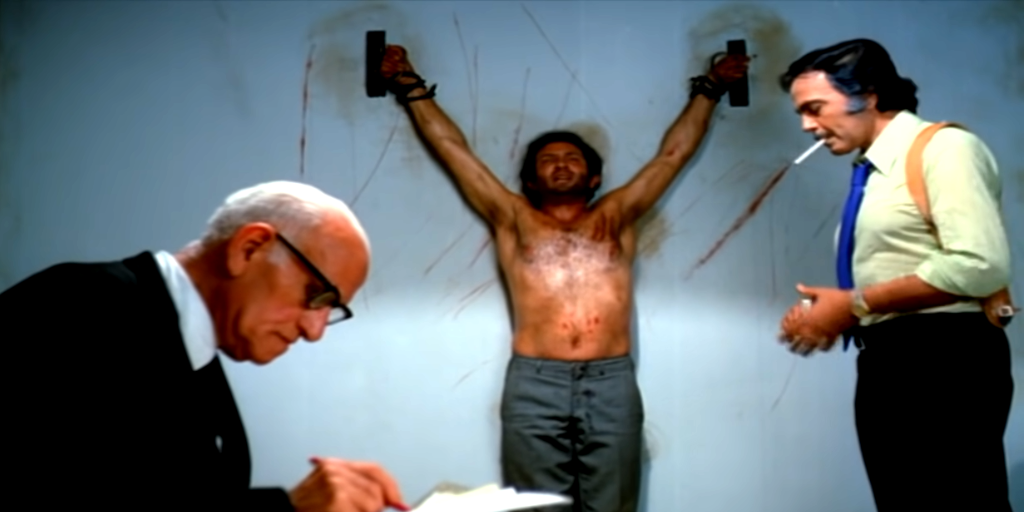Few movies have gripped the Egyptian consciousness like Al-Karnak (1975) had done upon its release. Based on Naguib Mahfouz’s titular novel (1974), the cinematic classic depicts candid political oppression, torture, rape, and paranoia unlike any film before it.
Graphic scenes typically startle audiences, but for Egyptians, those scenes were an opportunity to grieve their reality.
For the children of the 1952 Revolution, Al-Karnak was a cinematic rendition of the political traumas many had faced during the years building up to the 1967 Arab-Israeli War.
The premise of Al-Karnak is simple: a cafe in Cairo witnesses the story of three regulars, promising medical students living under the Nasser administration. This includes experiencing the Six-Day War (1967), War of Attrition (1967–1970), and the October War (1973). The students – Zeinab, Ismail, and Helmy – become enthralled with Egyptian politics and begin to take part in the cafe community debates.
Their seemingly-normal life takes a dark turn when the three of them are arrested. A riot in MahaIla El-Kubra, a textile town in the Nile Delta, pressures the General Intelligence Services to identify instigators – or create scapegoats if no evidence is found.
The regulars of the Al-Karnak café fit the bill.
Over the following months, the youngsters are arrested and put through investigative torture on the basis of being potential political dissidents. Once released, the three students hope to live normally once more, only to find themselves arrested and tortured again, while officials struggle to find a culprit and pressure mounts.
Ismail and Helmy remain imprisoned, whereas Zeinab was pressured into espionage for the government. The period they spend in custody, riddled with abuse and political coercion, mentally and physically breaks them. Outside of the prison gates, the free regulars of Al-Karnak witness the loss of the 1967 War, breaking their spirits as well.
When Anwar Sadat succeeds Nasser in 1970, the intelligence chief who tortured the three finds himself in prison, protesting to those he imprisoned – now his fellow inmates – that all he did was obey orders.
The film ends with Helmy dead due to police brutality, and Ismail released by presidential pardon. What remained was the shell of a man who had hoped to be a doctor, who now languishes in Al-Karnak. That is until a radio presenter announces Egypt’s victory in the October War.
Hope is lit once more in his eyes and he searches for a hospital to volunteer in to assist returning wounded soldiers. He crosses paths with Zeinab, now a professional doctor, who manages to obtain permission for him to join – forgetting yesterday to rebuild for tomorrow.
THE POLITICAL PARALLELS BETWEEN FILM AND REALITY
The end goal of the Al-Karnak is clear in its message: to de-Nasserize Egyptians of the past political traumas caused and to promote the recently-instated rule of Anwar Sadat.
The film portrayed Nasser’s administration as an apparatus that sapped the hopes of the 1952 Revolution through a decade of paranoia, torture, and lies. This is made evident when the director places a framed photo of Nasser in a shot, hinting that this was occurring under his watchful eye.
Furthermore, some argue the antagonistic role of the intelligence chief was heavily inspired by Salah Nasr, Egypt’s intelligence chief from 1957 to 1967. So similar were their characteristics that Nasr sued for defamation on the basis that the antagonist was portraying him.

Under Sadat’s watchful eye, who ordered a private screening prior to approving the film’s release, Mahfouz’s novella transformed from a resentful political commentary to cinematic propaganda that aimed to rile hope and support for Sadat’s Egypt.
The film is not as simple as moving on from Egypt’s political past. It was also part of then-president Anwar Sadat’s efforts to promote his Corrective Revolution, a political movement that aimed at purging Nasser’s political aides and reforming his predecessor’s policies. Many of Nasser’s aides, including Nasr, were imprisoned during Sadat’s ascension to presidency.
This method was not innovative by any means. Five years earlier, a Nasser-era film, Shorouk wa Ghoroub (Sunrise and Sunset) told the story of political oppression instigated by King Farouk’s rule prior to the 1952 Revolution.
In Mahfouz’s novella, far more resentful than its cinematic adaption, the plot ends with heartbreak as Egyptians discover the lies of the 1967 War and the years before. In the film, the film ends with Egypt’s victory in 1973 – a tweak to the story that favored the existing administration.
Despite evidence of state involvement in the film’s production process, the scenes remain true to Mahfouz’s commentary in terms of the challenges Egyptians faced from secret police, as a result of the political paranoia building up to the 1967 Arab-Israeli War.
One scene in the film highlighted how a secret police officer ordered a group of thinkers in Al-Karnak to disperse, as they were more than five people in a single gathering.
This referenced the archaic Crowd Laws of 1914, which banned social gatherings of more than five persons in public places under the guise of maintaining peace and security. The film argued Nasser’s regime would enforce that law extensively during the 60s in fear of political opposition congregating.
The film also touched on Egypt’s defeat to Israel in the 1967 War, and on the propaganda presented on national radios promoting false news of Egypt reaching victory in the war. When defeat was evident, it was only then that regulars of Al-Karnak knew the truth. That moment broke the spirits of the cafe, a reflection of the national sentiment at that moment.
It is through moments like the implementation of Crowd Laws and the 1967 defeat that the film compelled audiences to grieve past political traumas.
Al-Karnak is effectively a story about the defeated dreams of a generation who believed in the 1952 Revolution but ended up haunted by political oppression. As the film has aged, however, the film transcends the story, instead of becoming a means of correcting past policies and defeats in order to rebuild Egypt under new leadership.







Comments (4)
[…] woman who is forced to choose between love and providing herself and her family a better life, Al Karnak (in 1975), which is an adaptation of the book ‘Karnak Cafe’ by Naguib Mahfouz that seeps into […]
[…] Supply hyperlink […]